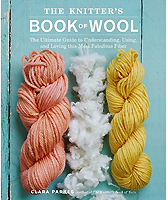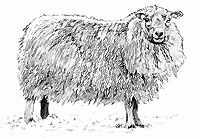
Nine wool yarns that launched a book | Woolalong on Ravelry | Errata | Clara's books
Pattern downloads (PDFs): Hill Country Hat, Cuff-to-Cuff Pullover


Where next? That was the question.
Creating the second of anything is always a challenge. If you're knitting socks, you want the second to be identical to the first (and we know how hard finishing that second sock can be). But if you're writing a book, you want to create something of equal value that can stand alone on its own two feet, no matter how much it gets compared to your first work. Did I even have another book in me, and, if so, what?
I didn't want to invest another two years of my heart and soul in a book unless I really believed it needed to be written and that I was the one to write it.
Enter wool.

One of my favorite things about Knitter's Review is that I get to discover and promote worthy yarns. Believe it or not, it's actually quite easy to create a yarn. Frighteningly easy in fact. Just contact a mill, look at their samples, and place an order. A few months later, a UPS truck shows up with a heck of a lot of yarn inside. Who knows where it came from, and who cares.
I'm drawn to yarns that have more of a story, whether it's the fibers, the mill, or the dyer. And the yarns I really love tend to come straight from the farm. Call me romantic, but when the hands that nurtured an animal hand you a skein of its yarn, you get a more meaningful, enduring product.
Fiber farmers do what they do out of love. They must because it's certainly not a lucrative profession. These people usually hold at least one other day job to support the farm, sometimes more. Fiber farmers care for their animals the way most people care for their children, staying up late when an animal is sick, never sleeping during lambing season, always worrying when they hear the howl of a distant coyote at night.
They fret over the increased costs of hay or feed and always hope that this won't be the year their property taxes finally become too prohibitive. And each time a mail-order catalog arrives, they wonder how they can possibly compete against a $5 skein of imported wool yarn, and if anybody really cares.
Wool matters
I say yes, we do. Very much so. We care about domestic yarn production. We care about having large open, undeveloped tracts of land where sheep may graze. We care about the skilled veterinarians who work in rural communities to keep these flocks happy.
We care about the shearers who travel from town to town, working their shears swiftly across the backs of thousands of animals each season. We care about the skilled millworkers who still know how to operate mill machinery and produce a good yarn.
We care about maintaining genetic diversity among our flocks, keeping distinct breed lines alive and pushing against the global wave toward one breed—white and soft—where hundreds could, and should, coexist quite happily.
So many traditions and locales and livelihoods are impacted by the choice of a skein, and the vast majority of those skeins are wool. Which is why I decided to write this book.
Touching wool
Because really, nothing beats wool. It's an extraordinary material—annually renewable and recyclable—with infinite potential. It can be wispy and sensual when it wants to be, it can be gruff and powerful, it can put out fires and keep families warm at night, it can be stepped on, sat under, rained on, and wrapped up in again and again.
Sheep have always been with us. Vikings deposited them everywhere they went (on ships whose sails were, themselves, made from wool), the British empire was built upon the Cotswold sheep, while the Spanish empire was built upon the Merino.
For me, the most exciting thing about wool is its diversity. Each breed, each flock, and even each animal can grow slightly nuanced fibers. While the majority of wool is still jumbled together and sold under that generic four-letter label ("wool"), more yarns are starting to sport actual breed names. Cormo, Corriedale, Rambouillet, Bluefaced Leicester, and others. What do you do with this information?
My goal with this book is to help you put a face to that name, learn more about how that breed came into being, and how the fibers will be at their happiest on your needles. Just as we care about what we put in our bodies, we also care about what we put on our bodies—and wool is a perfect start.
Enjoy the adventure,
![]()



